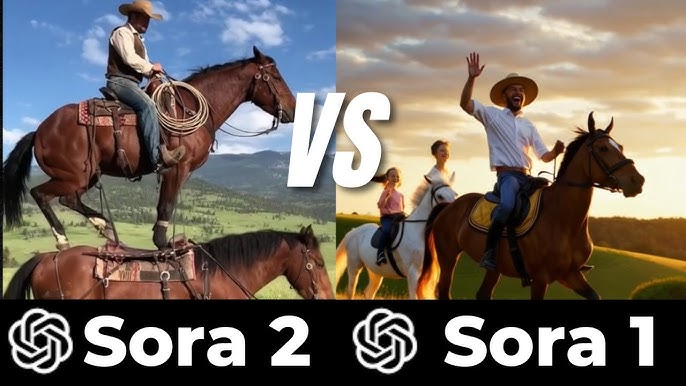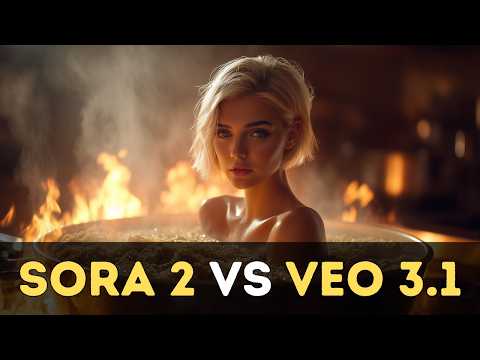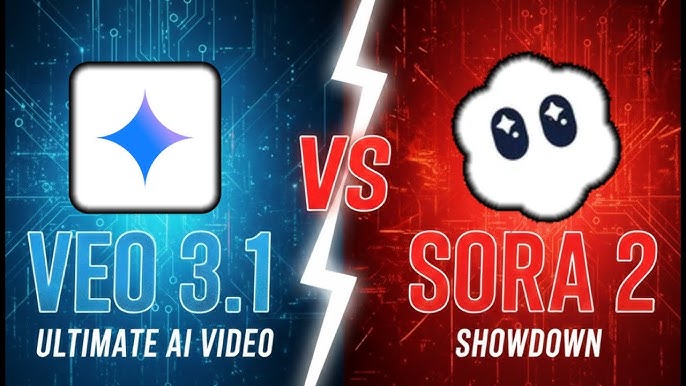Sora 2 vs. Veo 3.1: The Clash of AI Video Titans—Who Will Reign Supreme?
In the autumn of 2025, the field of AI video generation witnessed a seismic shift as two tech giants unsheathed their latest creations. On September 30, OpenAI unveiled its landmark model, Sora 2. Just two weeks later, on October 15, Google countered with its powerful competitor, Veo 3.1. This clash of titans not only showcases the breathtaking advancements in AI video technology but also heralds a new era of content creation. This article provides a comprehensive comparison of these two flagship models, exploring their respective strengths, technical approaches, and market prospects.

The Duel of Core Capabilities: Realism vs. Control
While both Sora 2 and Veo 3.1 aim to generate high-quality videos from text prompts, they diverge significantly in their methods and final output. Sora 2 strives for the pinnacle of physical realism, whereas Veo 3.1 focuses on providing creators with fine-grained, cinematic control.
| Feature | OpenAI Sora 2 | Google Veo 3.1 |
|---|---|---|
| Release Date | September 30, 2025 | October 15, 2025 |
| Core Strength | Physics simulation, audio sync, implicit agent behavior | Narrative control, multimodal input, fine-grained editing |
| Video Style | Natural, handheld feel, highly realistic | Cinematic, visually polished, slightly "artificial" look |
| Generation Length | 15s for free users, 25s for Pro (with multi-scene merging) | 4-8s base, extendable up to 148s |
| Editing Capability | Relatively basic, generation-focused | Powerful; supports object insertion/removal, frame control |
| Audio | First model with synchronized audio-visual generation | More comprehensive; supports dialogue, sound effects, ambient noise |
| Target Audience | General creators and casual users | Professionals, developers, and enterprise clients |
Sora 2: The Ambitious Path to a "World Simulator"
The release of Sora 2 has been hailed as the "GPT-3.5 moment" for AI video generation. Its most significant breakthrough lies in its astonishing ability to simulate the physical world. Compared to its predecessors and other models, videos generated by Sora 2 demonstrate a superior adherence to the laws of physics, light reflection, and fluid dynamics, drastically reducing uncanny, "anti-physical" phenomena. This "implicit agent behavior" makes elements within the video appear to operate on their own internal logic, achieving an unprecedented level of realism. For users eager to dive deeper and explore Sora's powerful capabilities, community hubs like gptsora.io offer the latest examples and tutorials.
However, by granting the AI greater autonomy, Sora 2 sacrifices some degree of user control. Its editing functions are relatively limited, making it feel more like a one-click "black box." This could be a constraint for professional creators seeking specific artistic effects.

Veo 3.1: The Precision "Scalpel" for Professional Creators
If Sora 2 is a powerful rendering engine, Veo 3.1 is a precision scalpel. Google has equipped Veo 3.1 with a formidable suite of narrative control and editing tools. For instance, the "Ingredients to Video" feature allows users to blend the styles and elements of multiple reference images, while "Frames to Video" intelligently generates smooth transitions between a start and end frame. Furthermore, the powerful "Insert/Remove" functionality makes post-production adjustments remarkably simple.
This level of fine-grained control gives it immense potential in commercial advertising, film pre-visualization, and other highly customized content creation. Imagine a future where creators on platforms like asmr.so could use Veo 3.1 to produce highly stylized works with unique audio-visual experiences. Yet, this sophistication comes at a price. Some users have noted a slight "artificial" quality in its videos, and its per-second pricing model presents a higher barrier to entry for individual users.

Conclusion: No Best, Only Best Fit
The competition between Sora 2 and Veo 3.1 is fundamentally a clash of two different technological philosophies and market strategies. Sora 2, with its stunning realism and ease of use, is poised to become a mainstream video creation tool, sparking a new content revolution. Meanwhile, Veo 3.1, with its professional-grade control and customizability, will carve out a niche in the enterprise and professional creative sectors.
For casual users and creators who prioritize speed and authenticity, Sora 2 is undoubtedly the more appealing choice. For filmmakers, ad directors, and developers who require meticulous control over the final product, Veo 3.1 offers an unprecedented degree of creative freedom.
Ultimately, this duel has no absolute winner. The true victors will be the creators who master these powerful tools to push the boundaries of creativity. As the technology continues to evolve, we have every reason to believe the future of AI video generation will be even more extraordinary.
References
- OpenAI. (2025). Sora 2 is here. https://openai.com/index/sora-2/
- Google. (2025). Introducing Veo 3.1 and advanced capabilities in Flow. https://blog.google/technology/ai/veo-updates-flow/
- 36Kr. (2025). Responding to Sora 2, Google releases new AI video model Veo 3.1. https://36kr.com/p/3511191054539655
Related Articles

What is ASMR Meaning?
ASMR refers to the tingling sensation that begins on the scalp and moves down the back of the neck and upper spine in response to specific auditory, visual, or tactile stimuli. Often described as "brain tingles" or "head orgasms," this pleasant sensation is accompanied by feelings of deep relaxation and euphoria.